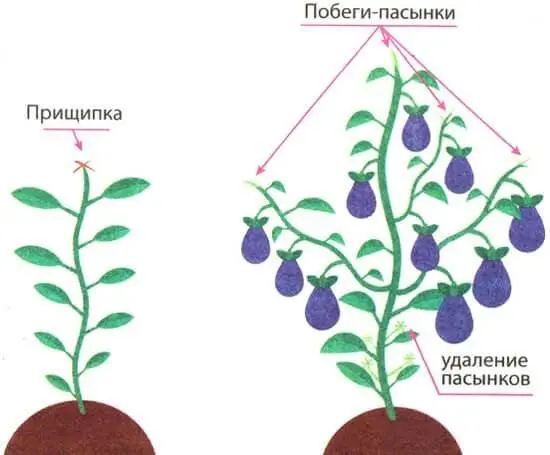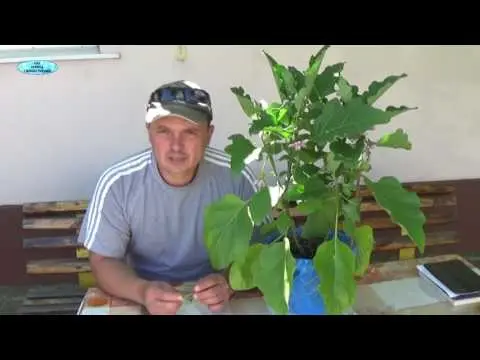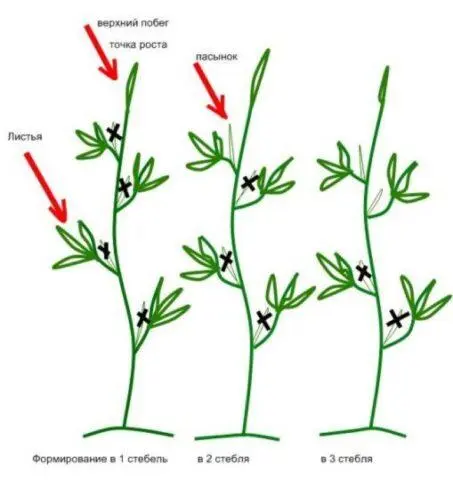Contents
Forming eggplants in a greenhouse is in most cases necessary, since there is not much space, and the bushes can grow profusely. Usually they are led in 1-2 stems. This is quite enough to get a good harvest. Less commonly, they lead to three stems (or more). You can start forming at the moment when the bushes have grown to 35 cm, but no later than the formation of ovaries. The procedure is performed manually, the cut points are sprinkled with wood ash or coal powder.
Do I need to trim the eggplant in the greenhouse
Most experienced gardeners agree that shaping eggplants when grown in a polycarbonate greenhouse is absolutely necessary. And this is especially important for plants in a greenhouse. Unlike open ground, they grow in a small room with limited access to light and air flow. Formation provides several obvious advantages at once:
- Plants will not spontaneously grow, the shoots will stop fattening. Thanks to this, all the nutrients and water will go to fruiting, which will have a good effect on the yield.
- If you properly cut the eggplants in the greenhouse, the light will evenly hit all the leaves and flowers, including those at the bottom of the bush. Therefore, you can count on the formation of all ovaries.
- Also, proper pruning helps to normalize the level of humidity, air intake, ventilation, which is especially important when growing in a greenhouse.
- If timely pinching is carried out, it is possible to prevent the spread of pests and diseases. After thinning, caring for eggplant is easier.
In most cases, gardeners do not have a question about whether eggplants are cut in a greenhouse or not. If it is not always necessary to do this in the open field, then in a greenhouse the procedure is usually necessary. But it also happens that there is too little time, and it is difficult to carry out pinching. In this case, it is recommended to grow undersized eggplant varieties in the greenhouse that do not require formation, for example:
- A delicacy;
- White Night;
- Diamond;
- Robin Hood.
When to form
There are no strict deadlines for the formation of eggplant bushes in a greenhouse – it all depends on growing conditions, the pace of plant development. As a rule, the procedure is started 17-20 days after the seedlings are transplanted into the greenhouse. At this point, the bushes are growing enough. And if nothing is done, they will begin to form on their own. Then you get a low sprawling bush, which is not necessary to tie.

Formation begins at the moment when the seedlings reach a height of 35 cm
But if you choose a certain step-by-step scheme and form eggplants in a greenhouse, powerful bushes will grow with a good harvest (as in the photo). It is better to start work in the early morning, when it is still cool enough. It is not recommended to work in dry, hot or, conversely, too humid weather. It is better if it is moderately warm outside.
It is necessary to be in time before the appearance of the first ovaries. Those. work should be completed at the stage of mass flowering.
Preparatory work
Before starting the formation of eggplants in the greenhouse, they need to be tied to a support, for example, a wooden peg. This is done so that the fruits do not bend the bush to the ground as they grow. Otherwise, they will be on the ground and may rot.
First, all the branches are tied up, since it is they that have the greatest load. It is best to make a support system using wires. But if this is not possible, you can stick strong wooden or metal pegs into the soil.
How to properly form an eggplant bush in a greenhouse
The formation of a bush is possible in one, two or three stems. Sometimes they even lead to 4-5 branches, but these are rare cases. To get a good bush, it is recommended to leave 1-2 of the strongest shoots, and pinch the rest. This will allow the plant to concentrate all the nutrients and water on these branches.
Pasynkovanie carried out manually, preferably weekly. The formation is done so that the stepchildren do not grow more than 5 cm. First, branching is planned, and then all young foliage and shoots below this point are removed.
Pinching should be carried out no later than one month before the end of the growing season. The fact is that after pruning, the plant spends quite a lot of time to recover. If you pinch later, it may adversely affect the yield.
Proper formation will ensure a good harvest even in a small garden.
After pruning eggplants in a greenhouse, it is recommended to organize enhanced care. It boils down to these steps:
- Regular watering at least twice a week. Water is taken settled, prepared in advance. It is most effective to water with a drip system, but you can use a watering can or a hose. Consumption rate – 1,5-2 liters per adult bush.
- In order for the formation of eggplants in the greenhouse to proceed correctly, it is recommended to apply top dressing. During flowering and the formation of ovaries, superphosphate (40 g per 10 l) and potassium sulfate (30 g) are given. Mineral top dressing can be alternated with organic matter (mullein 1:10 or bird droppings 1:20).
- The soil should be periodically loosened with a fork or rake to a depth of 5 cm. At the same time, weeds are removed.
- So that the soil does not lose moisture, it is recommended to mulch plantings with straw, sawdust, peat or other “breathable” materials. They retain soil moisture, and also inhibit the growth of weeds and even repel pests.
- Eggplants in a greenhouse are especially vulnerable during their development because pests, fungi, bacteria and other pathogens can enter through the wounds. Therefore, it is necessary to carefully monitor the plants and, if necessary, carry out treatment with drugs. From insects, insecticides are used, for example, Agravertin, Inta-Vir, Fufanon and others. Fungicides help to cope with fungi, for example, “Maxim”, “Skor”, “Bordeaux liquid”, “Tattu”.
Types of shaping eggplant in a greenhouse
The formation of eggplant in the greenhouse is carried out according to different schemes. Most often, bushes lead to one or two stems. But there are also cases when plants have to be formed in three shoots or even more. The choice is made depending on the characteristics of the variety and growing conditions. Each technique is described below.

The scheme of pinching and removing stepchildren
One stem
This eggplant formation scheme is used in cases where there is very little space in the greenhouse. It is necessary to choose the strongest and strongest branch, tie it vertically to stimulate growth processes. The angle should be as sharp as possible, but at the same time not so that a fracture occurs. All other shoots are removed from the bush. At the same time, it is necessary to cut off all the lower leaves of the eggplants in the greenhouse.
Further, 1-2 times a week, it is necessary to pinch the newly formed shoots along with their foliage and inflorescences. The plant will direct all its forces to only one main branch, due to which the fruits will be really large.
Two stems
The technique is the same, but now it is necessary to leave not one, but two of the most developed shoots at once. As soon as the bush reaches 35 cm in height, it is necessary to pinch the top, and wait a few days until the side stems form.
Several of them will appear. Among the shoots, the two strongest ones are selected, with a powerful “trunk”, and the rest are cut off. Then the sections are treated with coal powder or wood ash.
According to the same scheme for the formation of eggplants in a greenhouse, all shoots should be pinched to a height of 50 cm. They do not need to be completely removed. It is enough to remove the growth point and leave 1-2 leaves. When the plant enters the flowering phase, it is necessary to continue its formation, leading to two stems. 20-25 buds are left on each bush, the rest are removed.
More than three stems
If it is necessary to form three or more stems, the technique is exactly the same. During pruning, along with the main stem, another 2-3 shoots are left. They should be the most fleshy – then the probability of survival is close to 100%. All other processes going below are removed.

Comparison of three eggplant shaping methods in a greenhouse
Common mistakes
As can be seen from the description, the formation procedure is quite simple. But on the other hand, beginners and even experienced summer residents often make mistakes, which leads to a decrease in yield. To prevent them, it is recommended to follow these rules:
- You can pinch plants manually or with secateurs, scissors. Blades should first be sharpened and disinfected in a solution of potassium permanganate or other antiseptic.
- Pinching is done so that small stumps remain. “Under the root” it is not necessary to remove the shoots, since with such a formation the main stem can be damaged, which is fraught with infection.
- All sections should be treated with coal powder or wood ash. Otherwise, bacteria, fungi and other pathogenic microorganisms can penetrate into them.
- Often, summer residents leave too many ovaries, believing that the more there are, the higher the yield. In fact, when forming on each plant, it is worth leaving only 20 ovaries. If there are too many of them, the bush will be depleted, and the fruits will be crushed.
Conclusion
Forming eggplant in a greenhouse is not very difficult, since the principle is the same. It is necessary to pinch the growth point, pinch it and wait for the formation of several shoots. Among them, 2-3 of the strongest are left, and the rest are removed. Stepchildren should also be removed regularly. If you pay enough attention to this procedure, the harvest will be really good.









